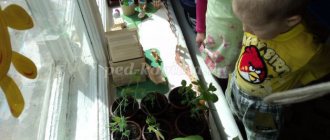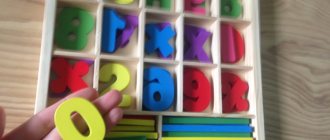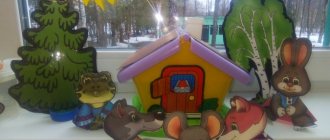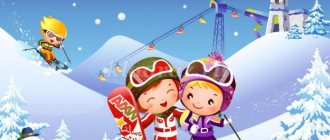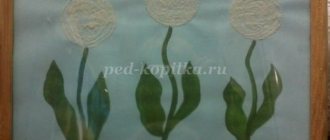Family project in the senior group of kindergarten on the topic: “Little discoveries in my big family”
You and I are growing up in a family circle
The basis of the foundations is the parental home.
All your roots are in the family circle,
And you come into life from family.
In the family circle we create life,
The basis of the foundations is the parental home.
There has been a lot of talk about traditions lately. These are loud words about “the revival of traditions and increasing the level of self-awareness of the nation,” and amazing stories about the customs of other countries, and advertising where everything is always traditional. Everyone knows that in Rus' all families had their own traditions, which united them, making them strong and strong. But, after November 7, 1917, the day of the October Revolution, many traditions were abolished, both folk and family.
Some, of course, remained, transformed. Some have sunk into oblivion. And, of course, new ones appeared. Views on the concept of “family,” on family loyalty, and on raising children have also changed. Many of the traditions that made a family a family were lost. Many families to this day are more reminiscent of people who live under the same roof, while having nothing in common, and sometimes even not knowing each other. But it is the family that gives a sense of stability and protection from early childhood, which we carry throughout our adult lives and pass on to our children, and so on from generation to generation, gaining wisdom and experience. Therefore, traditions are the basis of the way of life of a family, a family that is friendly, strong, and has a future. That’s why we need to revive traditions, family traditions. It’s good if all family members like them, because they are capable of bringing closer together, strengthening love, instilling mutual respect and understanding in the souls, something that is sorely lacking in most modern families. Children are raised not only by their parents as such, but also by the family life that develops. You can become involved in family traditions through the personal example of the parents themselves. It is with the family that the introduction to culture begins; the child masters the basics of material and spiritual culture. In a family environment, human forms of behavior are also formed: thinking and speech, orientation in the world of objects and relationships, moral qualities, aspirations, ideals.
The function of a kindergarten is the purposeful socialization of a child’s personality: introducing him to the world of natural and human connections and relationships, transferring to him the best examples, methods and norms of behavior in all spheres of life. Our kindergarten is attended by children of different nationalities: Russians, Buryats, Ukrainians, Tatars, Armenians, etc. The emphasis is on the fact that we are all different, but we have common interests, we need each other for a meaningful, interesting, kind life together. This is how the idea of implementing a project under the general name was born
Type of project: adult-children, cognitive-speech, creative.
Problem: In modern society, characterized by high activity, mental expenditure, and a lack of human warmth and attention, the connection between generations is lost, the family ceases to be a fortress and support for its members, traditions, customs, and the past are forgotten. The educational potential of the family is gradually weakening. But even ancient teachers believed that children should be raised with love and respect for their parents and veneration of ancestors, and to raise a future family man from an early age. I really want the thread connecting people in family relationships to be a thick rope capable of holding the entire family together.
Relevance: Raising a harmoniously developed personality is a priority in the new Law on Education. Such development is possible only in close cooperation between the preschool educational organization and the family. In connection with this, the need arose to develop this project for the development of family traditions.
Goal: to deepen children’s knowledge about the composition of their family, ancestry and family traditions.
Tasks:
— clarify and deepen children’s knowledge about their relatives, family ties and family members;
— give children the idea that each family is individual, has its own history, traditions, interests and foundations;
— create conditions to maintain interest for successful completion of the task;
— develop children’s cognitive-search activity;
— enrich parent-child relationships with the experience of creative activity;
— develop children’s speech skills to conduct a monologue and dialogue, talk about themselves, their family, using their personal experience;
— cultivate love and respect for your loved ones.
Project duration: one month.
Project participants: children of the senior group, their parents, group teacher.
Expected results: This project will help reveal to the child the world of national cultures, expand ideas about the way of life of the people inhabiting their native village, their customs and traditions, folklore; on the basis of cognition, promote the speech, artistic, aesthetic, moral, emotional and social development of children. By introducing children to the culture of their people and the nationalities living nearby, to form their idea of themselves and others as individuals. Fostering a sense of pride in students for their family, love for each family member; knowledge of your family history, family traditions and holidays. Creation of a system of joint activities: “child - teacher” and “child - parent” on this problem.
I assume that the main criterion for the effectiveness of this project will be the activity of parents in all activities carried out within the framework of this project, as well as the completeness and strength of children’s knowledge about the traditions of their family and their people.
Project implementation plan.
| 1st stage. Preparatory. | ||
| Name of the event. | Category of participants | Products of activity. Note. |
| Selection and study of literature and materials on the project topic: “Little discoveries in my big family” | Teacher Parents | List of references used (Appendix No. 1). List of children's fiction recommended for parents (Appendix No. 2) |
| Organization of an exhibition of children's fiction. | Parents Teacher | Exhibition of children's fiction (Appendix No. 3) |
| Development of a plan for a thematic week on the topic: “Family” | Educator | Appendix No. 4 |
| Consultation for parents: “The role of family traditions in raising children” | Teacher Parents | Appendix No. 5 |
| 2nd stage. Basic. | ||
| Event name | Category of participants | Product of innovation activity |
| Making an information sheet for parents: “What’s in my name...” | Educator | Appendix No. 6 |
| Conversations with children about family and family traditions. | Children Teacher | |
| Review of a presentation on the topic: “Family Heirlooms” | Children Teacher | Appendix No. 8 |
| Children's stories about their family tree. | Children Teacher | |
| Organization of joint play activities for children. | Children Teacher | |
| Productive activities of children. Decorative drawing “Gift for Grandma.” | Children Teacher | Abstract Appendix No. 11 |
| Productive activity. Application “Bird of Happiness”. | Children Teacher | Abstract Appendix No. 12 |
| Productive activity. Modeling “My Mommy” | Children Teacher | Abstract Appendix No. 13 |
| 3rd stage. Project presentation. | ||
| Mini-stories from parents on the topic: “Why did you name your child that name.” | Parents Teacher | |
| Family poetry evening. | Parents Children Educator | |
| Competition "Tender Treatment" | Parents Children Educator | |
| Children give gifts to their family members. | Children Parents Educator | |
The full version of the work is available.
Generalization of work experience “Family creative projects”
Family creative projects in preschool educational institutions.
Lavrova Lyubov Vladimirovna
teacher of MKDOU kindergarten "Fairy Tale"
Semiluki, Voronezh region.
Introduction:
The “Concept of Preschool Education” (1989) emphasizes that the family and kindergarten are chronologically connected by a form of continuity, which ensures the continuity of the upbringing and education of children. However, a preschooler is not a baton that the family passes into the hands of preschool teachers. What is important here is not the principle of parallelism, but the principle of interpenetration of two social institutions.
If you build an effective technology for interacting with parents through organizing interesting forms of work based on cooperation and interaction, you can increase the level of involvement of parents in the activities of a preschool institution.
According to the Federal State Educational Standard for Education, our kindergarten “Skazka” widely uses project activities with the family based on identifying needs and supporting the educational initiatives of parents. An important principle of our work with families is: “Let your parents into kindergarten, trust them more, and they will happily live every day in kindergarten with you.”
Target:
searching for effective forms of involving parents in the activities of a preschool institution
Research methods:
— study of children’s families;
— study of family experience in raising and educating children;
- accumulation and exchange of family traditions;
— education of parents in the field of pedagogy and child psychology;
— involving parents in active participation in the activities of preschool educational institutions through the organization of family creative projects and new effective forms of work.
Results and its discussion:
As a result of the work carried out, a model of interaction with the family was developed, which was based on family creative projects.
The result of using
family creative projects in preschool educational institutions
is that parents have become active participants in the educational process.
— The relationship between parents has improved, they have found common interests.
— Parents have become interested in the work of the kindergarten and raising children.
— The nature of parents’ questions to kindergarten teachers has changed.
— Parents have mastered the necessary practical skills in raising and teaching preschool children.
— Attendance by parents at pedagogical education events has increased, and participation in competitions, leisure activities, holidays, etc. has noticeably increased.
— Parents’ understanding of the practical and educational significance of their assistance to the kindergarten in economic and pedagogical work.
— Showing interest in active involvement in planning the educational process.
Description of the experience:
Family creative projects at a preschool educational institution.
Types of projects: creative, gaming, informational and practical, research.
Stages of work on projects:
1-preparatory
— familiarizing children and parents with the problem;
— setting goals and objectives;
— planning to achieve the goal, discussion with parents;
-involvement of specialists in the implementation of relevant sections of the project.
2-main
– collection of information, design and accumulation of material;
— classes, games, productive activities, competitions, promotions, master classes;
- independent activities, creative homework assignments and other activities together with parents.
3 final
— presentation of the project, final event.
Implementation deadlines:
long-term, medium-term.
Goal of the projects:
Implementation of interaction between kindergarten and family through involvement in the creative process and exchange of family experience in raising children and family traditions.
Long-term project “Live the spring of traditions”
Competition “Family coat of arms”, “Your genealogy, baby”. Research work on the design of the album “Family Chronicle” - about your family and relatives.
Project "Me and my family"
Presentation “My Family”, family game library of the weekend club.
Project “Little discoveries in my big family”
Family gatherings, a competitive program for the exchange of family traditions,
competition “Cookbook of the group “Bees”
Project "Our Heritage"
—opening of the mini-museum “Russian Izba”, which contains exhibits of the life of the inhabitants of our region, the historical chronology of our city in documents and photographs. (link to Internet resources)
-participation in the “Dobronezhets” campaign
Project “Book of Memory”
-
participation in the All-Russian competition "Great Victory: Family Album" - magazine "Preschool Education", meeting with WWII veterans, famous people of our city. — Competition “Letter to Great-Grandfather” - a message to the Hero of the Immortal Regiment,
Project “The City Where I Live”
— organization of family excursions, photo report, album “My City” (past and present)
Project on life safety “Every little child should know from the cradle”
- sports and game quiz “Experts of safety rules”
Project “Live long”
— educational quiz “Connoisseurs of healthy eating”
Family Newspapers Project
The best experience of family education is regularly presented in the form of photo newspapers, collective works, photo montages
Project "My Feathered Friends"
— participation in the “Skvorushka”, “Feed the Birds” campaign - making birdhouses, feeders and decorating a bird town
Project “Healthy Family – Healthy Nation”
— participation of families in sporting events, the “My Sports Family” competition.
Project “Ecological trail in a preschool educational institution”
— participation of parents in the design of ecological trail objects on the group’s site.
formation of “Alumni Alley” - tree planting.
“Health Path”, weather site Project “Holidays in preschool educational institutions”
- holding family holidays in which parents are both actors and participants.
Project “Visiting a Fairy Tale”
— joint production of fairy tales, production of costumes, scenery, theater screens. Competition "Do-It-Yourself Theater"
Project "Magic Colors"
— non-traditional drawing techniques, master classes with parents “Drawing coffee”, “Transforming a blot”
Project “School of the Old Woman Shapoklyak”
— evening games for children and parents, master classes
Project “Let's Play Together”
- creation of non-traditional play equipment, mathematical screen, lacing games, cork games, simulator "Kryshkograd", - game "Glade of Friendship" - Kryshkograd, "Find Whose Shadow", "Fairytale City"
Project "Book City" - design of the book city, mini-library, “Book tree - family reading”
Conclusions:
By participating in family creative projects, children, parents and teachers receive a creative impulse to develop their abilities, as well as emotional and spiritual support. Children get the opportunity to understand this or that information, and parents, unnoticed by themselves, enthusiastically pass on their knowledge and experience.
This form of organizing communication between teachers and parents plays a dominant role in improving the psychological and pedagogical culture of parents, and therefore contributes to changing the views of parents on raising a child in a family environment. Parents see the child in an environment different from home, and also observe the process of his communication with other children and adults - invisible threads of friendship and cooperation are stretched.
Thus, a feature of family projects is the special emotional microclimate of the family, thanks to which the child develops an attitude towards himself that determines his sense of self-worth, self-confidence, pride in himself and his family.
The main criterion for the effectiveness of this experience was the activity of children and parents in all activities held in the kindergarten, and a sincere desire to continue cooperation in new projects.
Bibliography:
1. “The concept of preschool education” (1989)
2. Arnautova E.P. Teacher and family. M., 2002
3. Veraksa N.E. Project activities for preschoolers: A manual for teachers of preschool institutions / N.E. Veraksa, A.N. Veraxa. – M.: Mosaic-synthesis, 2008.
4. Glebova S.V. Kindergarten and family: aspects of interaction. - Voronezh: TC “Teacher”, 2005.
5. Doronova T.N. and others. Preschool and family are a single space for child development. M., 2001
6. Project method in the activities of a preschool institution / Author-comp. L.S. Kiseleva [and others]. – M.: ARKTI, 2006. – 96 p.
7. Internet resources
Article “The invaluable role of parents in the project activities of preschool educational institutions”
The invaluable role of parents in the project activities of preschool educational institutions.
Communication between teachers and parents of students has always been and remains a pressing issue for kindergartens. One aspect of this issue is the search for effective ways of cooperation, which is equally necessary for both teachers and parents. Parents - in order to learn to understand the world of their child, teachers - in order to more effectively assist parents in this. And today we are no longer just talking about the exchange of information between parents and kindergarten teachers about the development, successes and difficulties of the child. The goal of the preschool educational institution’s work with families is to create conditions for a favorable climate of interaction with parents, to involve the family in a single educational space, and to establish trusting, partnership relationships with parents.
Objectives of interaction with parents: work closely with the families of pupils, activate and enrich the educational skills of parents.
The relevance is determined by the fact that existing trends and regulatory changes in the implementation of the Federal State Educational Standard in preschool education require from the teacher new forms of organizing the pedagogical process in kindergarten. The search for forms of joint activity of adults (teachers and parents)
and children. And here the project method turned out to be a successful find. Today it is becoming increasingly widespread in preschool institutions.
The project method promotes the development of independent thinking and also helps the child develop confidence in their own abilities. It provides for a system of education in which children acquire knowledge and master skills in the process of completing a system of planned practical tasks. This is learning through search and cognitive activity, which is aimed at the result that is obtained when solving a problem. The project method allows you to develop an independent and responsible personality, develops creativity and mental abilities, and also promotes the development of determination, perseverance, teaches you to overcome problems that arise along the way, and most importantly, the ability to communicate with peers and adults, increases the child’s authority in front of peers and his own self-esteem . At the heart of every project is a problem. After all, the themes of the projects are born precisely from the interests of children. The project method is characterized by group activity.
Thus, the project method becomes a way of organizing the pedagogical process, based on the interaction of the teacher, parents and students between themselves and the environment.
Project activities have their own distinctive features:
- It unfolds in a problematic situation that cannot be solved by direct action. For example, a child decided to draw an object and through the drawing convey his attitude towards this object,
he is faced with a design task related to research and search for forms of conveying his attitude to the subject.
- Participants in project activities must be motivated.
- Has a targeted nature. Since during project activities the child expresses his attitude, he looks for an addressee to whom his attitude is addressed, formalized in the form of a product.
Experience has shown that at first not all parents are willing to get involved
- joint activities with teachers and children, but then, after completing some tasks, they begin to understand how important their efforts are for the children, how pleasant it is to spend time with the children. Such joint project activities help to unite the team of parents. They get the opportunity to meet and get to know the interests of other families better and even make friends. The joint implementation of any plan between the child and his parents strengthens the child-parent relationship.
The project activity of a preschooler develops in stages.
Before 5
years, the child develops at
the imitative-performing
level. The lack of necessary life experience does not allow him to fully exercise independence in choosing a problem and ways to solve it. Therefore, the active role belongs to the adult. Attentive attention to the needs of children and the study of their interests make it possible to easily determine the problem “ordered” by children. As practice shows, children are happy to complete the tasks offered by the teacher. Interest in the content of the project depends on satisfying the child’s diverse interests; fulfillment of his needs for active activity and self-expression; passion for joint activities with adults.
Algorithm of actions
Step 1 - an intriguing beginning that meets the needs of children, identification of the problem by the teacher.
Step 2: The adult determines the goal of the project and motivates it.
Step 3 is to involve children in planning activities and implementing the plan.
The 4th step is the joint movement of adults and children towards results.
Step 5 - joint analysis of the project implementation, experiencing the result.
The first attempts of children to solve a problem on their own must be noticed and encouraged, informing the child about his success: “You came up with a quick idea!”; “It’s good that you came to the rescue in time!”
This helps the child become aware of his behavior, understand what he is doing right and where he makes mistakes.
By the end of the fifth year of life, children accumulate certain social experience that allows them to move on to a new, developing
design level. At this age, independence continues to develop, the child is able to patiently listen to the teacher and peers. Relationships with adults are being restructured: preschoolers are less likely to
they turn to them with requests, more actively organize joint activities with peers, they develop self-control; They are able to adequately evaluate the actions of both their own and their peers. They accept the problem, clarify the goal, and are able to choose the necessary means to achieve the intended result.
Algorithm of actions
Step 1 is to identify (by adults or children) a problem that meets the needs of the children or both parties.
Step 2 - jointly defining the goal of the project, upcoming activities, predicting the result.
The third step is planning activities for children with little help from adults, determining the means and methods of implementing the project.
4th step - children carry out the project, differentiated help from adults.
5th step - discussion of the result, progress of work, actions of everyone, finding out the reasons for successes and failures.
Step 6 - together with the children, determine design prospects
It can be seen that at the second stage the teacher’s activity decreases somewhat. He doesn’t so much form his own ideas as he gets involved in the implementation of his students’ ideas. It is important for adults to become interested in what children are interested in and help them expand their goals and objectives.
Preschoolers not only show a willingness to participate in projects proposed by adults, but also suggest problems and topics for possible research, adventure and other projects.
The topics of projects can be very different,
however, topics based on children's interests provide better motivation and more successful learning.
A teacher who listens to children, asks them questions about what interests them, and finds many topics for organizing projects. Was there something happening in the garden or in the local community that the whole group was interested in? Has any of the children had a little brother or sister? Has the circus come to town? If some exciting event for children occurs, such as the arrival of a circus, children can choose it as the theme of their joint project. The circus theme can be developed in one group over a month or even longer. The duration of the thematic project depends on the degree of interest in it of the majority of children in the group. The degree of this interest is determined by the teacher.
One of the most effective ways to develop thematic projects involves the use of the so-called three questions model.” The essence of this model is that the teacher asks the children three questions:
- What do we know?
- What do we want to know?
• What should you do to find out?
First, the teacher begins a general discussion so that the children find out what they already know about a certain subject or phenomenon. As the children answer the question, the teacher writes their answers on a large sheet of paper for the group to see. You need to write down the answers of all the children and indicate their names next to them. Then the teacher asks the second question: “What do we want to know?” The answers are again written down on a large piece of paper. The children's answers determine the content of the thematic project, and all answers are recorded, no matter how stupid or illogical they may seem.
When all the children have spoken, the teacher asks: “How can we find answers to the questions?”
Methods of collecting information can be different: reading books, contacting parents, specialists, conducting experiments, thematic excursions and much more.
The results of each project are discussed with the whole group “What have we learned?”
You can ask children the following questions:
- Who learned something new for themselves?
- Did you learn anything that you didn't know before?
- Did you learn anything that surprised you?
- Which of the activities in the project did you like the most?
Based on the results of the project, the teacher can make decisions about improving and expanding such projects in the future.
There are three main types of project activities: creative, research and informational - each of which has its own characteristics, structure and characteristic stages of implementation.
Research projects are individual in nature and contribute to the involvement of the child’s immediate environment in his area of interest.
- Research project activities can be divided into the following stages
.
Involves creating a situation in which the child independently comes to the formulation of a research problem.
The teacher creates a problem situation for all children, and then observes the children’s activities and identifies the areas of interest of each child. A special situation is created that helps the child formulate a research problem and attract parents to create a project.
Project design. Parents help the child, but the child is the organizer.
Project protection. Together with the parents or one child tells how the work was carried out.
- An exhibition is organized, and at the end of the exhibition the projects are freely available.
Projects not only enrich preschoolers with knowledge, but also stimulate their cognitive activity.
In the course of creative project activities, a new creative product is created. It is carried out collectively or together with parents. This project differs from the previous one in its long-term nature.
The following stages can be distinguished in creative project activities.
- Discussing project topics with children and parents.
- The motives for children’s participation in the upcoming activity and their attitude towards it are determined.
- Children express their ideas for implementing the project. The teacher notes the most original ideas as they speak, so that in the future, if the children do not reproduce them, he can remind them.
- Invite children to sketch their ideas and think about what is needed to implement these ideas.
- Children talk about their drawings and answer questions from the teacher and peers. At the end of this stage, the best idea is selected.
- Information for parents. A drawing of the project is posted and
Name.
- The teacher organizes working groups to complete the project, and parents solve technical issues.
- The teacher and the children decide how best to present what they have received.
product.
- The product of the creative project is presented. Such project activities are aimed at showing
to the child the significance of his efforts for others.
- information-practice-oriented project activities.
Children collect information and implement it, focusing on their own interests (design of the group, individual corners, etc.).
Stages of information project activities: Identification of children's initial knowledge.
Information for parents about upcoming activities. Help parents in selecting fiction and non-fiction literature.
Selection of didactic, plot-based role-playing games. Selection of experiments for conducting experimental activities.
Design and defense of the project (together with parents or independently). The project product is presented.
- theatrical project activities
What does a teacher need to know and be able to do when organizing theatrical activities?
- Be able to read expressively, tell stories, look and see, listen and hear, be ready for any transformation.
- An emotional attitude to everything that happens, sincerity and genuineness of feelings, intonation of voice.
Project activities can be carried out in several directions.
- In the form of direct educational activities.
During classes: listen carefully to the children’s answers and suggestions; if they don't answer, don't insist. Give children the opportunity to play with a character from the work themselves, ask who seems to have succeeded and why.
- In the form of a game.
- Constant inclusion of theatrical games in the pedagogical process. Content and variety of topics.
- Cooperation between children and adults, both in organizing the game and
- during.
- All games and exercises must be selected in combination with movements, speech and facial expressions, pantomime.
- "Immersion in a fairy tale."
- Joint reading and analysis of fairy tales.
- Playing excerpts from a fairy tale.
- Director's play (with construction and didactic
material)
. - Drawing.
- Verbal, board and outdoor games.
- At the end of the work, it is advisable to discuss its advantages and disadvantages together and be sure to note the child’s real achievements.
In the form of pedagogical situations.
One of the factors for successfully planning projects and presenting them to children is the professional experience of the teacher. Some topics are of particular importance to most children aged 3 to 7 years. The list of such topics includes family, pets, babies, seasons, cars, justice, favorite foods, music, and shopping. In a word, those things that children directly encounter in everyday life.
In order to organize the educational process most effectively, the participation of not only the teacher and children of the group, but also their parents is necessary.
It is with the help of parents that the developing subject-spatial environment in the group is updated. Where the main place is occupied by hand-made toys made from waste materials. Parents, children and teachers not only take part in joint activities, but also see the result of joint work, which contributes to emotional rapprochement and the formation of a holistic sensory experience. Thus, parents, participating in the implementation of the project, are not only sources
information, real help and support for the child and teacher in the process of working on the project, but also become direct participants in the educational process.
They enrich their teaching experience, experience a sense of belonging and satisfaction in this.
There is such a variety of projects as family ones. For example: “My family tree”, “Our family
traditions”, “The Great Patriotic War in the history of my family”, etc. They have enormous developmental potential for children. And for their implementation, the participation of parents is simply necessary.
Bibliography:
1. Project and research activities in a preschool educational institution: from idea to implementation: Collection of methodological materials / I.A. Syrova, O.G. Chekhovskikh. - Samara: Publishing house SFMSPU 2009. - 72 p.
2. Project method in the activities of a preschool institution: Manual // L.S. Kisileva, T.A. Danilina, T.S. Lagoda, etc. - M.: ARKTI, 2003 - 96 p.
3.Prokofieva L.B. A look at the quality of education from the perspective of a methodological approach. Collection of scientific works / L.B. Prokofieva, G.A. Voronina; edited by I.M. Osmolovskaya. - M.: ITiIP RAO, 2004. - P.503.
4. Sapranova S.I. Project activity / S.I. Sapranova // Preschool teacher. - 2008. - No. 2.
5. Sidenko A.S. Project method: history and practice of application / A.S. Sidenko // Journal “Head of Principal”. - 2003. - No. 6.
6. Timofeeva L.L. Project method in kindergarten / L.L. Timofeeva. —
St. Petersburg: Publishing House “Childhood-Press” LLC, 2011. - 80 p.
7. Shansky N.M. School etymological dictionary of the Russian language.
Origin of words / N.M. Shansky, T.A. Bobrova. - M.: Bustard, 2004. - 398 p.
8.Shtanko I.V. Project activities with children of senior preschool age / I.V. Shtanko // Management of preschool education. - No. 4. – 2004
- Mayer A.A. Management of innovation processes in preschool educational institutions: Methodological manual / A.A. Mayer. - M.: SFERA shopping center, 2008. - 128 Pakhomova N.Yu. Project-based learning - what is it? / N.Yu.Pakhomova. // Methodist. - 2004. No. 1.
- P.42. Pedagogical design - a resource for the development of preschool education: Collection / Responsible. G.N.Masich. - Krasnoyarsk: KIMC, 2010. - 78 p.
Social project “Together a friendly family”
Analysis of the situation
A survey conducted among students and parents (legal representatives) of the Interschool Educational Center shows:
45% of students have a low level of creative (social) activity;
21% of parents do not want their child to participate in various competitions, cultural events, and promotions;
53% of teachers lack educational interest in the history and cultural heritage of the city, region, country;
35% of parents do not know the history of the city, region, country;
62% of parents do not have the opportunity to visit cultural institutions of the city and cultural events with their children due to high employment.
The task of educating a creative personality with an active civic position was traditionally solved in an interschool educational center, but the results of the study showed the need to strengthen work in this direction and fill it with new content. Therefore, there was a need to change the forms of organization of the pedagogical process through the organization of joint events for children and parents.
Analysis of the situation made it possible to identify the following contradictions: on the one hand, there is an objective need to educate a creative personality with an active citizenship, and on the other hand, for its implementation in institutions of additional education, traditional methods and forms of educational work are used. From these contradictions the following problem arises: what modern forms and methods of educational work can be used in raising children?
The idea arose of developing a joint sports, technical, patriotic event for children and parents. Hence the theme of the social project “Together a Friendly Family.”
This project was developed in accordance with the Law of Education, the standard Regulations of an additional institution, the Declaration of the Rights of the Child, the Charter of the MBUDOMUK. The project is the organization of recreation for adults and children on weekends in the form of a game-travel through the creative grounds of the station, aimed at promoting the development of joint activities in the form of competitions.
Relevance
The issue of spiritual, moral, patriotic education of children is one of the key problems facing every parent, society and the state as a whole.
The modern child is in a boundless information and huge social space that has no clear external or internal boundaries. He is influenced by flows of information received through the Internet, television, computers, and cinema. The educational and socializing influence (not always positive) of these and other sources of information is often dominant in the process of development and education.
The modern child lives with the illusion of freedom. The removal of many restrictions and prohibitions in virtual information environments is accompanied by a drop in the child’s trust on the part of adults. A growing person is not taken, as was the case several decades ago, beyond the boundaries of children's affairs and concerns, and is not included in the solution of real problems of the family, local community, and state that is feasible for him. Isolating children from the problems that adults live with distorts their socialization and disrupts their maturation processes.

